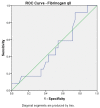Can Serum Fibrinogen Predict ARDS?
- PMID: 32733125
- PMCID: PMC7372612
- DOI: 10.1177/1178633720943505
Can Serum Fibrinogen Predict ARDS?
Abstract
Acute respiratory distress syndrome (ARDS) has a worldwide mortality of 10% to 30% with severe pneumonia being the primary cause. Diagnosis relies on clinical criteria which may lead to under-recognition and delayed evidence-based interventions. In previous studies, plasma fibrinogen was associated with progression to ARDS among patients with severe pneumonia. This is a prospective cohort study wherein we hypothesized that levels of plasma fibrinogen and change in levels of fibrinogen can predict development of ARDS among a cohort of patients with severe pneumonia based on the Infectious Diseases Society of America (IDSA) and the American Thoracic Society (ATS) consensus criteria. After acquiring consent, plasma fibrinogen levels were extracted upon enrollment and after 48 hours. These extraction times were arbitrarily chosen to determine whether levels rise or decline in relation to the course of disease. A total of 47 patients were prospectively followed within 7 days of enrollment, then divided into 2 groups, which included those who developed ARDS (n = 12, 25%) and those who did not (n = 35, 75%). Fibrinogen levels at baseline had sensitivity and specificity of 41.7% and 57.1%, respectively (P = .932) with an area under the curve (AUC) of 0.492; levels after 48 hours had sensitivity and specificity of 55.6% and 65.6%, respectively (P = .729) with an AUC of 0.538; and delta fibrinogen levels had sensitivity and specificity of 55.6% and 62.5%, respectively (P = 0.581) with an AUC of 0.561. Based on this study, plasma fibrinogen is an unreliable biomarker for predicting ARDS development in patients with severe pneumonia. In setting up this study, we experienced limitations which we had to accept but realizations of these led to the discovery of potential research areas. To our knowledge, this is the first Philippine study attempting to discover a biomarker for ARDS progression. It is recommended that further investigation on local incidence and other biomarkers for ARDS should be done.
Keywords: ARDS; biomarkers; fibrinogen; severe pneumonia.
© The Author(s) 2020.
Conflict of interest statement
Declaration of conflicting interests:The author(s) declared no potential conflicts of interest with respect to the research, authorship, and/or publication of this article.
Figures





References
LinkOut - more resources
Full Text Sources

